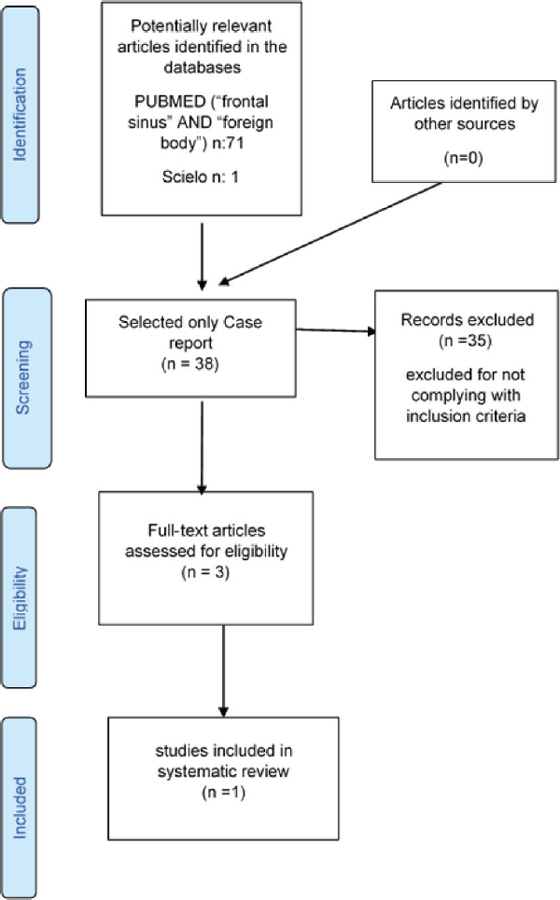INTRODUCTION
Accidents with foreign bodies of all types have been described in most parts of the body. The presence of foreign bodies (FB) are common complaints in urgent and otorhinolaryngology consultations. The most common places are the natural head and neck cavities.
FB in the paranasal sinuses are extremely rare in clinical practice [1]. More than 50% of the sinus foreign bodies are located in the maxillary sinus. The incidence of a foreign body in the frontal, ethmoid and sphenoid sinuses is nearly equal [1]. Foreign bodies in the frontal sinuses are rare [2].
The foreign bodies found in the sinuses are retained roots of teeth, fragments of wood or bamboo, pieces of cotton or gauze, bullets, shrapnel fragments, knife blade and glass fragments [1].
The most frequent cause of the presence of FB in the paranasal sinuses is maxillofacial trauma (about 70 percent), followed by trauma resulting from dental treatment [1], displacement of tooth roots inwards of the maxillary sinus [3] and self-inoculation [4].
Due to its prominent location on the head, the frontal sinus is frequently involved in facial trauma [5], but despite its vulnerable position, the frontal sinus is not a frequent site of lodgment of foreign bodies [1, 6].
Foreign body penetration on frontal sinus is of particular apprehension because of the close proximity of the frontal lobe and duramater to the posterior sinus wall [5].
The existing literature on frontal sinus foreign body is limited [6].
The presence of foreign bodies should be suspected in lacerations of frontal region in cases of maxillofacial trauma [1], and so, in the case of trauma to the frontal sinus, it is important to carefully explore the cavity in search of any fragment of FB [7, 5].
The presence of frontal sinus FB can be asymptomatic and go unnoticed for years or have recurrent infections due to obstruction of the nasofrontal canal [6].
Frontal sinusitis can result from the entry of microorganisms together with the FB or by blocking the nasofrontal canal[8]
Access to the frontal sinus for removal of a foreign body typically needs an external ethmoidectomy approach or osteoplastic flap [8].
MATERIAL AND METHODS
Type of study: systematic review of the topic.
Research question: How foreign bodies appear in the human frontal sinus and which foreign bodies are more frequent?
Eligibility criteria: For the selection of studies, the following inclusion criteria were used:
Language: Portuguese, English or Spanish.
Publication date: 2010 to 2020.
Availability: full text.
Article type: case report.
Traumatism or iatrogenic events in human resulting in foreign bodies in the frontal sinus.
Exclusion criteria:
Information sources: The studies were retrieved from PubMed (https://www.ncbi.nlm.nih.gov/pubmed/), Cochrane (https://es.cochrane.org/es), Scopus (https://www.scopus.com/sources.uri) and Wos (https://www.recursoscientificos.fecyt.es/), Scielo (Scientific Electronic Library Online), from 01 January 2010 to 18 November 2020 (last date of search). The search included Portuguese, English and Spanish studies, following the PRISMA guidelines for systematic reviews (https://www.equatornetwork.org/reporting-guidelines/prisma/).
Period: Information sources were consulted between 24 December 2020.
The search strategy and article selection are summarized in Figure 1.
Search: "Frontal sinus" AND "Foreign body"
Study selection:
1st Stage - the titles and abstracts of the references identified through the search strategy were evaluated and the potentially eligible studies were pre-selected.
2nd Stage - the full text evaluation of the pre-selected studies was carried out to confirm the eligibility.
Data collection process:
Data were extracted by reviewer and checked by the remaining reviewers for accuracy. We used Rayyan® (Mourad Ouzzani, Hossam Hammady, Zbys Fedorowicz, and Ahmed Elmagarmid. Rayyan — a web and mobile app for systematic reviews. Systematic Reviews (2016) 5:210, DOI: 10.1186/s13643-016-0384-4; https://rayyan.qcri.org/welcome) for the selection and for the duplication extraction process.
Data items: The variables for which data were sought age, sex, symptoms, etiology and type of foreign bodies (Human, Sinusal trauma, Foreign body).
Risk of bias across studies: Since only 1 study were found eligible for this review, we considered there is a publication bias in this review and any conclusion from this study will only reflect this one scenario.
Ethical considerations: Being a research based on the literature review, it did not need prior ethical permission.
Weaknesses and limitations: Limited number of studies founded.
We used the PRISMA checklist when writing our report [9].
RESULTS
Of the 72 articles identified by means of information sources, 34 were excluded because they were not clinical cases, determining a selection of 38 clinical cases. Of these, 35 were excluded for not complying with inclusion criteria. 3 Full-text articles assessed for eligibility. Of this, 2 records excluded for not being related to the topic under study, only one case remaining.
DISCUSSION
Of the articles found there are only one study about foreign bodies located in frontal sinus from Ear, Nose & Throat Journal [10]. One patient of 34-year-old man with headache and fever for the past 7 days was diagnosed as having a comminuted fracture of the frontal sinus, where he had had a cranioplasty 15 years earlier with Methyl methacrylate to obliteration of the frontal sinus. The MRI suggested an abscess in the left frontal sinus (iatrogenic event). Methyl methacrylate is a monomer of acrylic resin usually used in a variety of medical, dental, applications.
The major limitation of this research is the number of articles found in a vast period of 10 years in three languages. However, in the gray literature we find many clinical cases.
CONCLUSIONS
Accidents with foreign bodies are common in ENT clinical practice, however, in sinus location are very rare. The maxillary sinus is the most common site. Although the frontal sinus is more prominent on the face. Foreign bodies are rare. Most of them result from trauma by accident, gunshot or surgery or dental treatment.















